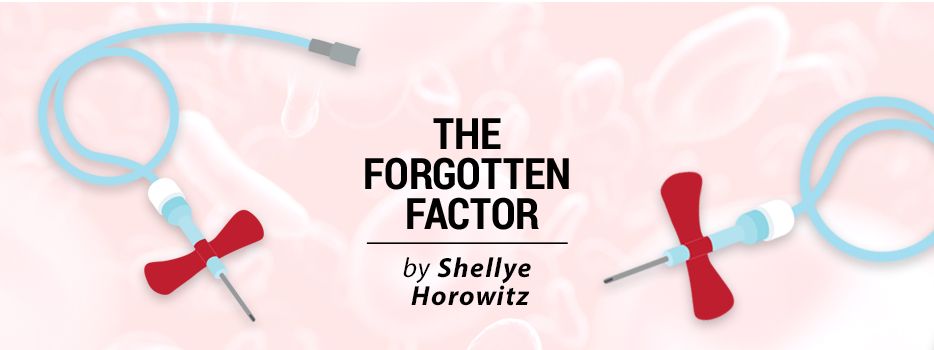We Need a Standard of Care in Women’s Hemophilia Treatment

I visited a hemophilia treatment center for the first time in the 1980s, to have my factor levels tested. The phlebotomist couldn’t find a vein, and I was distraught.
Workers ended up pinning me down to get my blood. The result was that my factor VIII levels were “elevated” for me — in the high 30s — due to the stress of the blood draw. I was labeled an “asymptomatic carrier” of hemophilia.
Take 2
In the late ’90s, I visited a second hemophilia treatment center in a new city. They drew my blood and saw that my levels were in the mid-30s. (I was on birth control, which can raise factor levels.) They labeled me a “possible symptomatic carrier.”
Here comes center No. 3
In the early 2000s, I moved again and went to a third hemophilia treatment center in another country. They drew my first “accurate” factor VIII levels, with no hormones or stress. My factor VIII levels were 20%. They labeled me as having “mild hemophilia.”
Next, they gave me factor for a few medical procedures and used tranexamic acid as part of my treatment. This country did not use the term “symptomatic carrier.” They were the first center to emphasize my need for treatment plans.
Loss of hemophilia label at center No. 4
In the early 2010s, I moved yet again and established myself at hemophilia treatment center number four. My factor VIII levels remained the same as when I lived abroad, 20%, but they changed my label back to “symptomatic carrier.”
I got factor VIII products when I had surgical procedures, but when I injured my ankle and it took nine months to heal, no one considered that the injury could be related to hemophilia. My ankle finally healed when I infused factor VIII for an unrelated medical procedure.
5 centers and a change
Around 2015, I moved (yes, I know — again) and went to a fifth hemophilia treatment center. They still referred to me as a “symptomatic carrier.” My levels remained at 20%. They gave me factor VIII products for surgeries, and then started helping me get factor more often, as I was starting to see more joint bleeds as I headed into menopause.
Although I was never denied factor, they did admonish me to “not waste expensive factor” on multiple occasions when I suspected I was bleeding.
After a major surgery during which I used tons of factor VIII products over 30 days, my diagnosis changed to “mild hemophilia.” The change was made so that my insurance would pay for the factor VIII.
Center by choice, not location
Later in the decade, I realized I might not have been getting the treatment I needed. I moved myself to hemophilia treatment center number six. They were highly recommended for the work they do with women who have bleeding disorders.
They came up with a treatment plan, provided access to factor, and encouraged me to infuse if I questioned whether I was bleeding. I was no longer told not to “waste expensive factor,” and was encouraged to treat as needed.
While the treatment was great, I was again labeled a “symptomatic carrier.” I cried when I read the label, as it had been a barrier to treatment in my past. I asked for the label to be removed from my records and replaced with “mild hemophilia.”
They listened.
My levels dropped in menopause to 13%, and my bleeding issues worsened. I was placed on prophylactic treatment for protection.
Different centers, different labels
The six hemophilia treatment centers treated and labeled me differently. It was confusing, frustrating, and showed a flaw in the current system for treating hemophilia.
When someone is diagnosed with diabetes, their diagnosis remains “diabetes.” If it is determined they need insulin, they receive the medication. If they need to move to another city, they would assume their medication regime would continue. There is no question whether or not they would continue to receive the insulin they need. There is a standard of care.
We must have the same standard of care in hemophilia. I know many women who are afraid to switch treatment centers because they feel it may result in losing a treatment plan that is working well. In an ideal world, it would be understood that the next center would honor the established treatment plan. This would be more probable if there were a standard of care throughout our community.
A consistent standard of care must be established when diagnosing and treating women with bleeding disorders. It is important to know that all women will be taken seriously and treated appropriately. It is also important that care is standardized so a woman does not have to start over and fight for treatment if she moves from one treatment center to another. Lives depend on it.
***
Note: Hemophilia News Today is strictly a news and information website about the disease. It does not provide medical advice, diagnosis, or treatment. This content is not intended to be a substitute for professional medical advice, diagnosis, or treatment. Always seek the advice of your physician or another qualified health provider with any questions you may have regarding a medical condition. Never disregard professional medical advice or delay in seeking it because of something you have read on this website. The opinions expressed in this column are not those of Hemophilia News Today or its parent company, Bionews, and are intended to spark discussion about issues pertaining to hemophilia.







Paul Clement
Good article!
G Shellye Horowitz
Thank you, Paul!
Susan Inwood
This article made a tear come to my eyes. I live in New Zealand and we are considered to have mild Haemophilia 30% and under I believe. I have four children-both sons have Haemophilia and one daughter is considered a carrier at this stage-her three children have unknown diagnoses.
It heartens me that women are now being looked at differently in the bleeding community and hopefully young women won't have to go through what us "oldies" had to with each and every doctor/specialist we encountered. So- thank you for your article.
G Shellye Horowitz
Thanks for your kind words. We have a long way to go, but are so much better off than we used to be. Keep advocating for appropriate diagnosis and treatment!!!